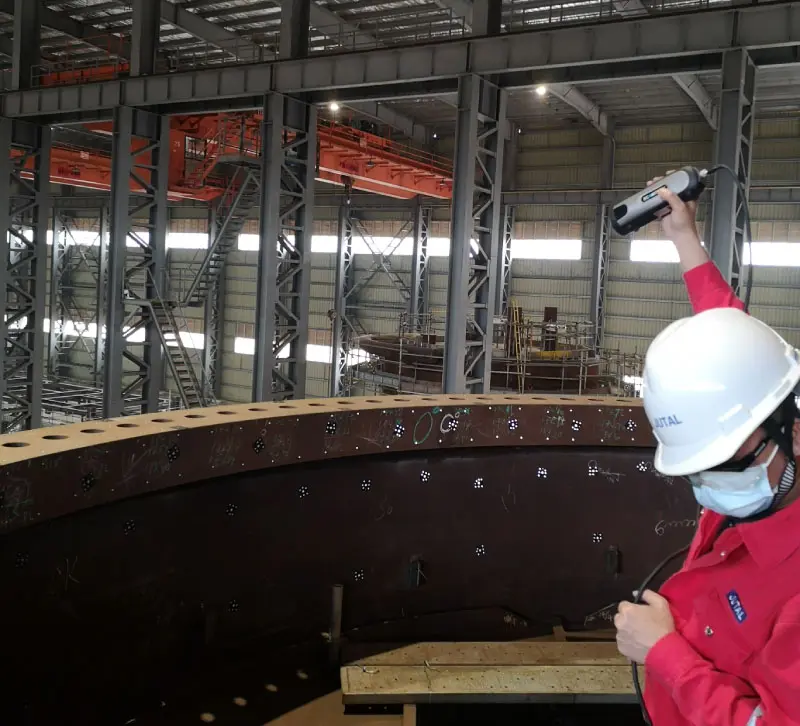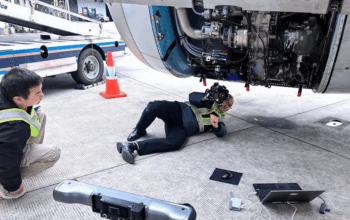Summary
Using Scantech’s portable 3D laser scanner KSCAN-Magic and photogrammetry system MSCAN-L15, technicians from a wind power equipment manufacturing business measured and examined a sizable flange of an offshore wind power foundation.
The project’s goal was to record the data in its entirety and check to see if it adheres to the specifications for geometric dimensioning and tolerancing. Inspection of the 120 bolt holes revealed particular GD&T, including location and flatness, which were recorded.
Background
Growing numbers of enterprises are using wind power, a clean, sustainable, and renewable energy source, to provide electricity. Compared to conventional fossil fuels, it has a far lower environmental impact.
Both onshore and offshore wind farms made up of numerous individual wind turbines, produce wind energy. Offshore wind farms have costly development and maintenance costs. Thus, it is essential to make sure the wind turbine and tower components adhere to strict standards.
Goals of the Project
Jutal Offshore Oil Service Co., Ltd., a company founded in 1995 and listed on the main board of the Hong Kong Stock Exchange since September 2006, is the client in this instance.
It offers customers in the oil and gas business services for offshore engineering, building modules, and manufacturing cutting-edge oil and gas equipment.
Utility-scale wind turbines are big, heavy machines with parts that are typically substantial in size. The flange can be up to 6 metres wide and 10 meters high.
In order for the flange to effectively fit into the base of an offshore wind turbine, the company wants to measure and check it to make sure it complies with GD&T specifications.
An optical 3D laser scanner should measure the object and check the flatness and parallelism of its surfaces. It is necessary to take measurements for the bolt holes’ diameters, positions, angles, and other factors. The precision of measuring findings must be within 0.1 mm.
Challenge
Large-scale Part
The component has a diameter of 6 meters and a height of 10 meters in the form of a cylinder. The part’s topmost flange is the one that needs to be measured. It is challenging to measure such a big section that is also so far up.
Harsh Conditions on Shop Floor
Vibrations are caused by the handling and product equipment, such as machinery and cranes, on the shop floor. Since the flange must be tested on-site, ambient vibrations may unavoidably affect the measurement results. Also, the shop floor is covered in dust and welding sparks, which makes measurement extremely difficult.
High Volume of Measurement Tasks
The technicians had to do a large number of measurement activities quickly because they needed to determine, for example, the locations of 120 bolt holes on the GD&T.
Disadvantages of Traditional Methods
The customer’s measurement tools were conventional ones like a caliper and an electronic total station. They are unable to handle the measuring jobs because of their inability to acquire fully filed data, poor measurement accuracy of just around 0.5 mm, complex operation, and low efficiency.
Particularly, conventional measurement techniques can only measure two-dimensional characteristics, such as the distance, and they are unable to measure three-dimensional GD&T factors, such as the location of bolt holes.
In addition, the lower surface of the flange is difficult to access and too thin for the electronic total station to measure.
The electronic total station’s measurement is significantly impacted by ambient vibrations and dust, and the inspection report does not live up to the expectations of its clients.
Advantages of Scantech’s 3D Solution
High Accuracy
Engineers can assist in obtaining accurate measurement results by combining the photogrammetry system MSCAN-L15 with a volumetric accuracy of up to 0.015mm/m and the handheld 3D scanner KSCAN-Magic with an accuracy of up to 0.020 mm.
Full-field Data
Scantech’s 3D solution facilitates the gathering of full-field 3D data with robust 3D scanning and can be utilized for additional archiving. To make sure the part is qualified and can fit into the foundation precisely, the whole data can be used.
Unaffected by Harsh Conditions
With a strong algorithm and an aerospace-grade aluminum alloy construction, KSCAN-Magic is resistant to the vibrations, dust, and sparks of its surroundings.
It may be carried anywhere and used to do measurements because it is lightweight and portable. The KSCAN-Magic 3D scanner’s durable qualities make it the best choice for on-site measuring.
Intuitive Data for Inspection and Maintenance
Users of professional analysis software can obtain clear and thorough data and results. The information gives technicians references so they may create repair plans appropriately. They decreased the number of repairs and increased efficiency by basing their corrective measures on more accurate statistical assessments.
Click on the following link Metrologically Speaking to read more such blogs on Metrology.










